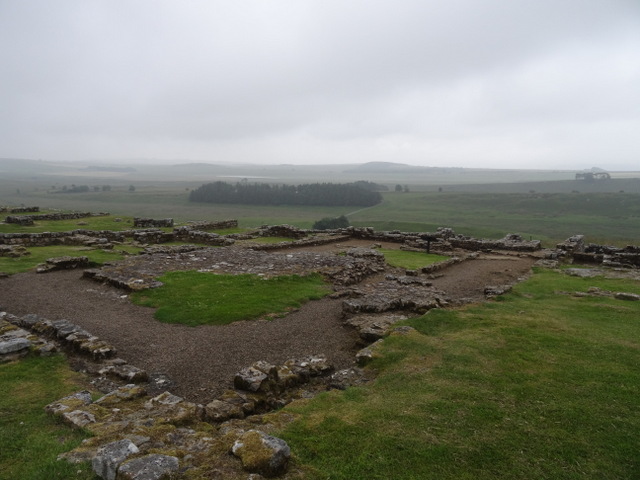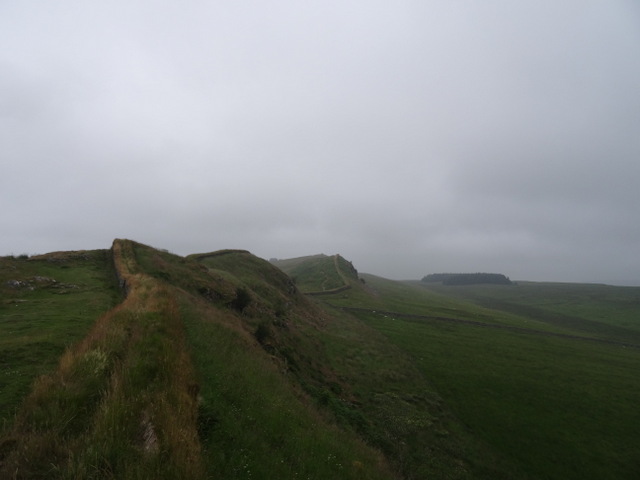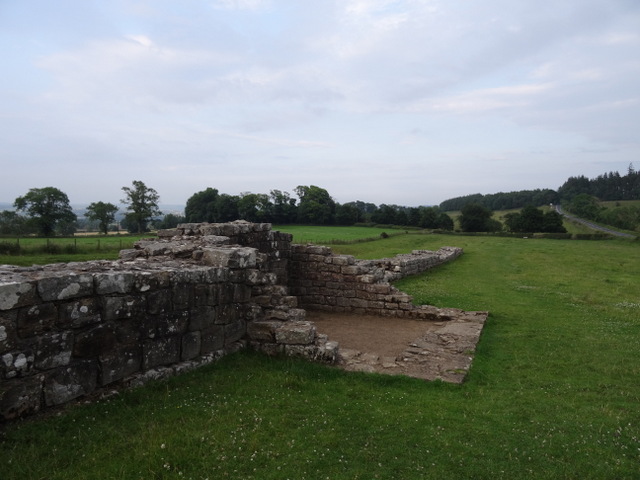We Brits, or so the stereotype goes, like talking about the weather. And that’s how this weekend trip to Hadrian’s Wall begins. When we left Edinburgh, it was raining: fat raindrops filling the windscreen, no matter how fast the wipers tried to clear them. On the bypass, it felt as though the tarmac was going to disappear beneath swimming pool-esque puddles, as the clouds continued to empty themselves. And when we hit Northumberland National Park, it was still pelting it down.
There’s a Scotland/England Border Viewpoint on this route, but there was no view to speak of: just grey cloud and lashings and lashings of rain. The A68 looks quite nice and straight on Google Maps, but let me tell you something: the stretch between Jedburgh and Cottonshopeburnfoot is bendy and twisty and not at all fun in the rain.
You can imagine my relief when the rain stopped just as we reached Greencarts Campsite and Bunkhouse, our base for the weekend. We wasted no time in pitching the tent while it was dry and befriending the only farm cat which liked socialising with campers (a gorgeous ginger cat, since you ask). With plenty of time on our hands, we did what Brits do best and headed for the pub. As soon as we spotted sticky toffee pudding on the menu, it turned into a drinks and dessert pub trip.
Fog greeted us in the morning. We weren’t meeting my family until lunchtime, so we stopped off at Housesteads Roman Fort en route. We managed to book tickets via their website there and then in the car park, though I expect on a brighter day that mightn’t be possible. After donning our waterproof coats and trousers (I was taking no chances after all the rain the previous afternoon), we set off up the hill.
We started with the museum, as there was no queue. (Social distancing restrictions were still in place at the time of our visit, and we were advised there might be a lengthy queue if we waited until later.) This was the Goldilocks of museums: not too small and scant on detail, not too big and overwhelming, but just the right amount of artefacts and information.
Each cabinet illustrated a different aspect of life in the fort, complete with dozens of items found on archaeological digs at the site. Everything from hob-nailed shoes, keys and jewellery to glass flasks, tweezers and ceramic pots was on display. I found it fascinating – and it brought back memories of my dad reading The Eagle of the Ninth (an adventure novel set in Roman Britain) with me as a child.
Housesteads Roman Fort – or Vercovicium to the Romans – is the best-preserved of all the forts along Hadrian’s Wall. Construction began in c. AD 124, and the fort was occupied by up to eight hundred soldiers for nigh-on three centuries. Beyond the fort’s walls, was a vicus – a civilian settlement, with shops, inns, temples and pastures, which fulfilled the soldiers’ basic needs.
Housesteads Roman Fort, we learnt, is known for its latrines, so that was our first stop. Rewind many, many centuries, and picture the scene. Wooden benches surround the central platform; doing your business is a social activity. Moss, leaves or bracken are on hand for you to wipe your nether regions (I wonder what the Romans would’ve thought about last year’s loo roll shortages). Water flows through a shallow channel on the central platform: that’s hand-washing sorted. And your waste is flushed away with rainwater, courtesy of an extensive drainage system. Whatever else you might think or say about them, the Romans were remarkably inventive.
Our next stop was the bathhouse (balneae), which would once have held two rooms: a changing room with a cold plunge bath, and a heated room with a hot plunge. Although Housesteads Roman Fort is very well-preserved, to the uneducated (read: me) there are few visual clues to distinguish one ruined building from another. This was where the plaques dotted about across the site came in handy, as they plugged the gaps for us and brought the fort to life.
Much of the space within Housesteads Roman Fort was filled by barracks. Each of the ten barracks accommodated a century (that’s eighty men) and was split into ten rooms, plus a larger one for the centurion in command. Each of the ten rooms was then split in two, with the front portion used for storing weapons and kit, and the rear for sleeping. If you were an estate agent, you’d probably describe them as ‘cosy’ or ‘snug’ – words any would-be tenant or buyer will attest means ‘cramped’ and ‘poky’. Around AD 300, the barracks were redeveloped: instead of one long building divided into many rooms, fewer individual ‘chalets’ filled the space, perhaps indicative of a smaller garrison.
Next up: the granary (horreum), which would have held not only grains, but all kinds of food needed to sustain the soldiers. Again, the Romans had thought of everything: vents in the walls and raised floors to allow air to circulate; an overhanging roof to keep rain away from the walls; and two large entrances to make it easy to unload supplies from the carts.
Moving to the western edge of the fort, we came upon the remains of one of several bakehouses (pistrinae). Soldiers would have baked their own bread, and other food, here; in the photo below, the curved wall is part of an oven.
We explored the remains of the hospital (valetudinarium) next. A courtyard would have filled the central space, around which there would have been a series of small rooms for tending to the sick and wounded and storing medical supplies, offices and a latrine. It was, so the sign informed us, rare for auxiliary forts (i.e. forts housing soldiers) to have hospitals, and yet both Housesteads and Segedunum (in present-day Wallsend, at the eastern end of Hadrian’s Wall) had hospitals. Our last stop was the headquarters building (principia), a place of order, ceremony and tradition. Here, soldiers would have received their orders from commanders; worshipped their gods; and received their pay packets.

We had just enough time for a short walk, so we headed up the field to the west of the fort to join the Hadrian’s Wall Path (a national trail which follows the whole course of the wall). We passed through woodland and, no more than ten minutes later, were rewarded with a lovely view of the wall following the contours of the hills towards the horizon.

We met my family for lunch in Wetheral, and then spent the afternoon wandering round Carlisle together. Carlisle Cathedral had already closed for the day by the time we got there, but we enjoyed a wander round the gardens while the sun was shining. If ever I’m passing through Carlisle again, I’d be tempted to stop off and see the inside of the cathedral, as it has a beautifully decorated blue ceiling and some gorgeous stained glass. We rounded off our time in Carlisle with a caffeine-fix, and then got well and truly soaked on our way back to the car.
When we reached the campsite, there were still a good few hours of daylight left in the day. We stuffed snacks and water bottles into our rucksacks, laced up our walking boots and set off to make the most of the long summer evening. Within ten minutes or so, we joined the Hadrian’s Wall Path at Black Carts Turret. When Hadrian’s Wall was built, there was a milecastle every Roman mile* and two smaller turrets between each milecastle.

Wondering why the turret is wider than the wall? The Romans had originally planned for the wall to be 3m thick, and built the turrets accordingly. Perhaps it then hit them just how far they had to transport their building materials, as the wall they ended up building was 1.8m thick and left some of the turret’s walls exposed.
We followed the Hadrian’s Wall Path as far as Chesters Roman Fort (which sadly isn’t visible from the road, as it’s tucked behind a small wood), and then cut up a small lane towards Lincoln Hill (where a wedding reception was in full flow). At the top of the lane, we turned left and shortly after picked up a footpath on our right. Ahead of us, a small owl flew out of the trees, presumably off to catch its tea.
We passed through a field of cows (cute) and then a field of slugs (yuck). I hate slugs, so I was not a happy bunny. Someone had at least passed through this overgrown field before us and trodden a path, but there were slugs – of all shapes, sizes and colours – everywhere. I was beyond relieved when we reached Rye Hill and could leave the slug-filled field behind.
A couple of hundred metres lay between us and our tea: ‘just add water’ vegetable couscous, followed by a slice of birthday cake (thanks, Mum!). By this point, the light was beginning to fade and an energetic bat was swooping around the field near our tent – camping entertainment at its finest.
KNOW BEFORE YOU GO
- Attractions | We chose to visit Housesteads Roman Fort, but there are heaps of others you could visit round here. You’ll need to book an entry ticket for a timed slot, and pay for car parking (£3 for 3 hours, and £2 an hour thereafter). I’d recommend allowing two hours to see everything, and closer to three if you’re visiting with small children or someone with reduced mobility.
- Parking | We parked at Water Street Station Car Park in Carlisle (£3 for 3 hours), but there is a plethora of car parks around the city centre.
- Maps and guides | OS Explorer OL43 covers Housesteads Roman Fort (should you wish to do a longer walk from there) and the route we did near Black Carts Turret.
- Distance | 8.68km/5.4 miles; 197m of elevation gain.
- Misc. | Greencarts Campsite and Bunkhouse, near Walwick, is a great option if you’re exploring the area on a budget; in July 2021, a tent pitch was £8 per adult per night.